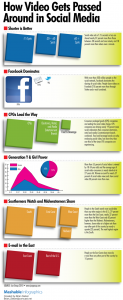It’s Tuesday morning; you flip on your computer and see a funny video in your Facebook feed. You automatically hit the share button, with a little note about how this video is so funny. You have just added to the viral juice of this video, and most likely you shared it because it hit one of your main emotions. It was funny and it made you smile. This is one the most common reasons for sharing videos on the Internet. Most of the time the video needs to be short and funny for it to “go viral”.
So why has the most shared video of 2012 completely gone against conventional wisdom? KONY 2012 is 29 minutes long and isn’t funny at all, yet it has been seen more than any other video so far this year, at last count it was viewed 73,999,551 times since being uploaded on March 5th. It has also been shared more than 7.6 million times on Facebook and embedded in more than 6,200 blogs. There have been nearly 5,000 news sources that have written about “KONY 2012”.
There is a recent study that was done by the University of South Australia. The study identified the emotions that are most likely to be shared across the social web. They found that most videos are amusing or boring, and most of them don’t go viral. They found that videos, which evoke marked physiological responses, such as laughter, anger, crying, or shock are most likely to be shared. So if you laugh or cry, you are more likely to share than if you smile or frown. Videos that evoke positive emotions such as exhilaration, hilarity, astonishment, happiness, and inspiration are more likely to be shared than negative emotions such as anger, disgust, sadness, shock or frustration.
What does this mean for video marketers? Knowing the emotions that people respond to and are most likely to share is a great indicator of how to make content in the future. One lesson learned is that laughter is not the only way to get people to share your video, although hilarity is easily the most likely emotion to get your video shared.
The “KONY 2012” video shows us that the stronger the emotion, the more likely a video will get shared. This says pick the emotion you are aiming for and then crank it up. Being positive is a much safer bet when doing this as anger can lead to users becoming irritated and cause a backlash.
Of course this data doesn’t tell the full story, there can be things happening offline, the possibility of you having used the product before, and if the video is being promoted in one way or another. Also you might find a video hilarious that I find disgusting or vice versa. The main takeaway is we never know which video will catch on, however the stronger the emotion that video evokes, the more likely it will be shared. Humor is no longer the only factor when making a viral video.
Here is the “KONY 2012” video in case you haven’t seen it and a funny marketing video about shaving.
KONY 2012
DollarShaveClub.com
Which one do you like more, is one more effective than the other? Tell us what you think, how can this affect SEO, or Social Media?



